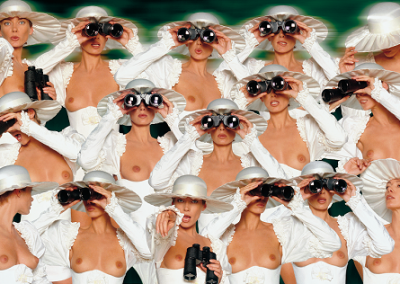WORKS
Gunter Sachs | Augen & Gitter | 1980 (Abzug: 2010) A.P. | c-print kaschiert auf Alu-Dibond unter Acrylglas | 72 x 108 cm
Gunter Sachs | Strandgut | 1987 (Abzug: 2003) A.P. | c-print mit passe-partout, gerahmt mit Glas | 93 x 73 cm
ARTIST Info
Gunter Sachs
In the 1970s, Gunter Sachs (1932-2011) achieved extraordinary fame as a photographer. Sachs was already involved in black-and-white experimental photography at the beginning of the 1950s, but it was not until he was commissioned by Vogue and took numerous experimental photographs that his career as a fashion photographer and photo artist took off. Sachs achieved his international breakthrough as a photographer in 1974 at the “Photokina” trade fair in Cologne, for which he not only designed the official poster but also succeeded with a first comprehensive exhibition of his photographic work. Two years later, the industry-wide recognition was once again confirmed when Sachs was awarded the prestigious Leica Prize (1976).
Excerpts from an essay in “Gunter Sachs Kamera Kunst – Photographie, Film und Sammlung”, Edition Hirmer, Munich
Courtesy of Otto Letze, Institute for Cultural Exchange, Tübingen 2023
Sachs again demonstrated his pioneering spirit in this field: he experimented with long exposures and highspeed camera technology. Sachs was one of the first artists ever to create digital image compositions, which were first shown in 1995. He caused a sensation in 1973 with the first nude photograph on the cover of French Vogue and it will not be the last time he pays homage to the aesthetics of the female body. It is no coincidence that the title of his first book of photographs 1974 is “Mädchen in meinen Augen” (Girls in my Eyes), for nudes form the focus of his photographic work alongside landscape and architectural photographs, still lifes and experimental photography.
Whether in commissioned works for the fashion industry or in his free artistic photographs – Sachs always stages the beauty of his, mostly female, subjects; abysmal, even ugly things have no place in his work – he seeks and surrounds himself with beauty. His artistic mission is committed to his unconditional need for aesthetics and if one should call him “a daydreamer or an old-fashioned aesthete” because of this, then he wants to “let it stand unchallenged”.
The preferred motif of his photographs is the female nude, which he knows how to stage in spectacular pictures of lightness, movement, and dancing poses. At first, he produced romantic-poetic works, but soon the backgrounds became more abstract, and Sachs often used the deep azur-blue sky of southern France as a monochrome surface in front of which the stylized female body was silhouetted. Sachs increasingly leaves the terrain of depictive photography and becomes an artistically motivated light photographer who creates idiosyncratic pictorial compositions using light and backlighting in a technically adept manner.
In terms of subject matter, symbolism, composition and lighting, Sachs was strongly oriented towards the surrealist works in his art collection, such as Dalí, Yves Tanguy, Giorgio de Chirico and Renée Magritte. Above all, their method of combining dreamlike and real pictorial elements serves Sachs as inspiration for his own works. In the creative process, he benefits from his love of experimenting with advanced techniques such as multiple exposures, the use of different filters, flash shots with variable light values and digital processing. It enables him to photographically transform and express the moods previously created by painting. In photographs such as ‘Ascot’ from the 1980s, Sachs already shows in these early works that he draws his artistic inspiration from the tradition of Surrealism. With serial ironization, or photographs with women’s bodies dominated entirely by blue tones, he succeeds in creating suggestive atmospheric images that immerse us into the world of the night, the dream, and the subconscious.













